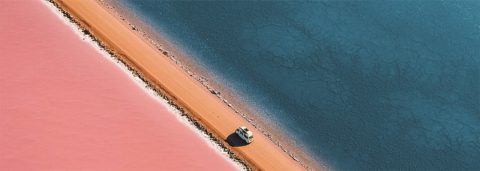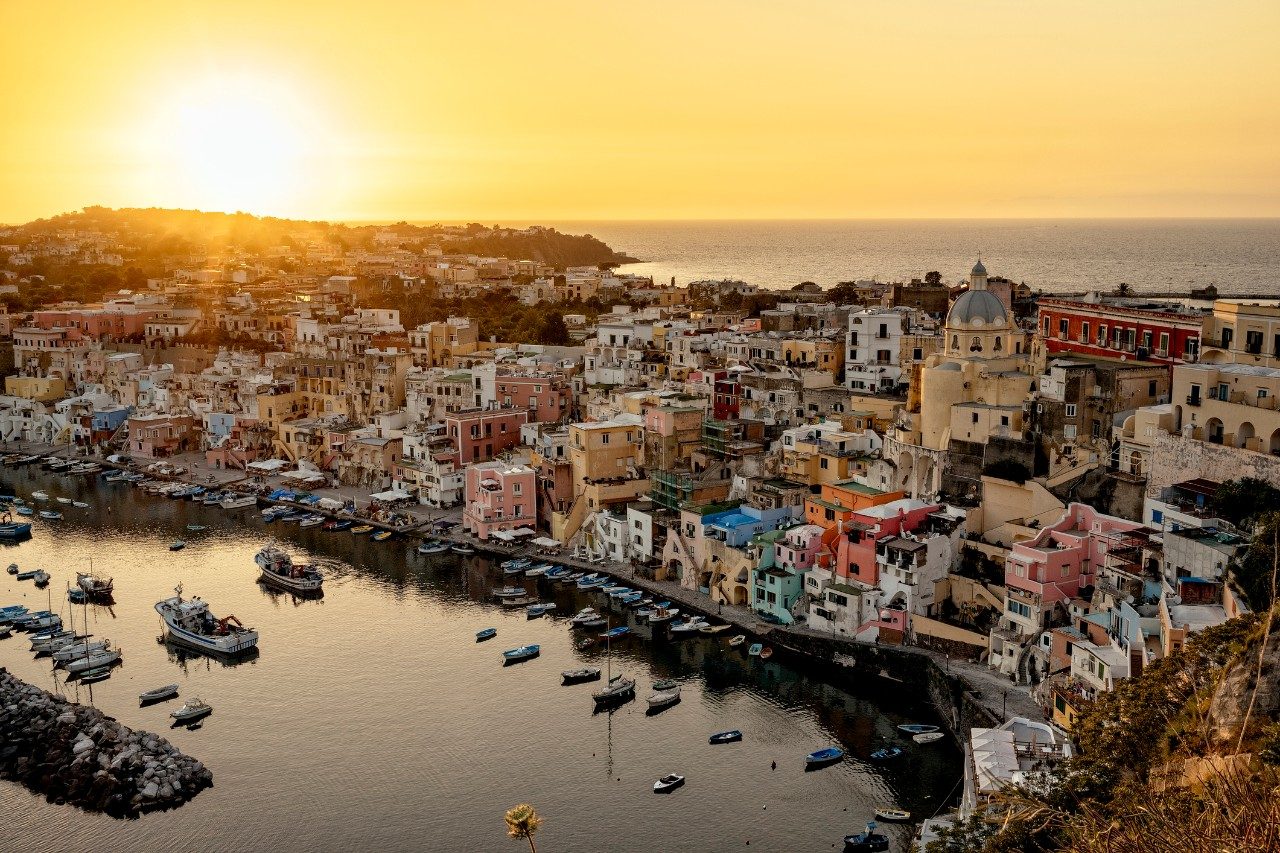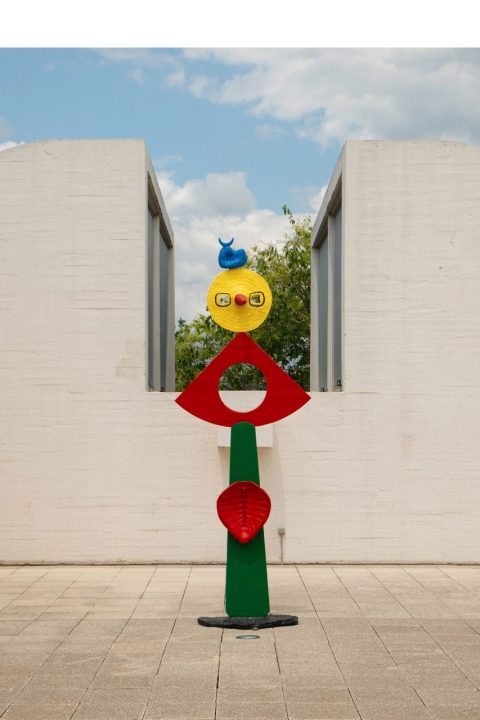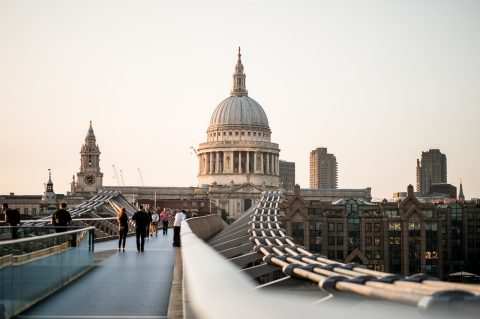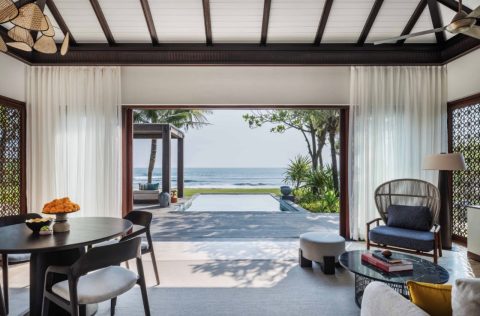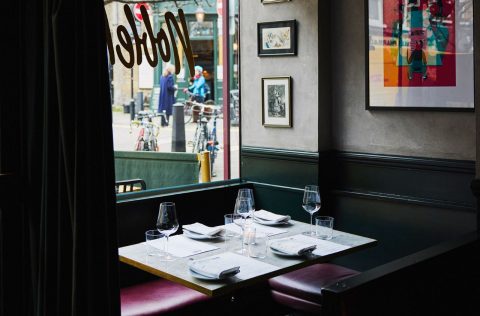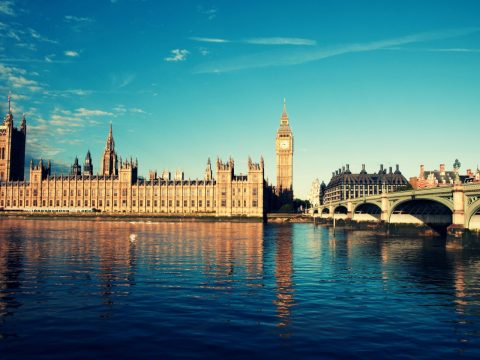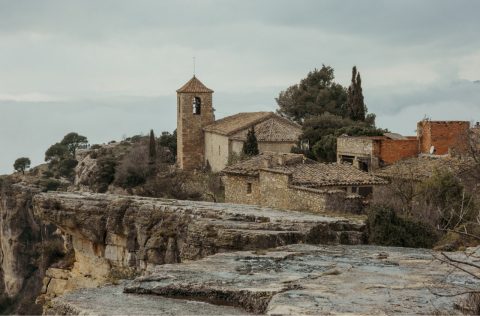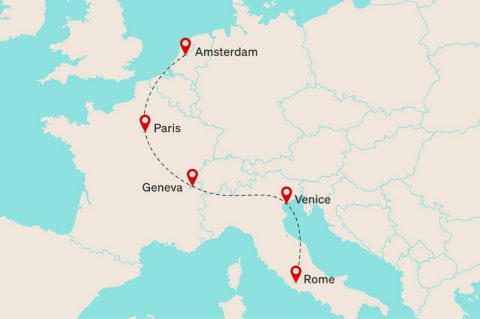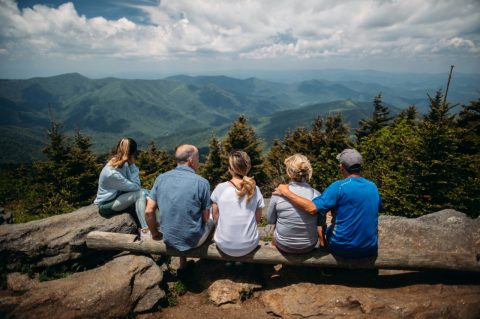Explore 29 of Europe’s Most Beautiful Lakes
While Europe’s rich cultural history and medieval landmarks attract their fair share of visitors, its stunning natural wonders offer an equally compelling allure. With over 500,000 lakes scattered across the continent, there are plenty worth planning a trip around: some lie within UNESCO-heritage listed national parks while others are tucked into dramatic alpine landscapes, many capturing the essence of laid-back European summer perfection. Here are 30 of the most spectacular, from Switzerland to Slovenia, to inspire your next adventure.
Image credit: Christian - stock.adobe.com
Eibsee, Germany
1/30A two-hour drive southeast of Munich, and resting at the foot of Zugspitze mountain, the wonderfully clear Eibsee practically begs you to dive into its cool depths. Luckily, you can do exactly that – preferably in summer, when the water hits a welcoming peak of 20 degrees Celsius – after taking the seven kilometre hiking loop around the lake’s edge and working up a sweat.
Image credit: Digitalpress - stock.adobe.com
Grüner See, Austria
2/30Surrounded by snow-capped mountains and alpine meadows, there’s no question as to how Grüner See (Green Lake) got its name. While there’s no swimming allowed for conservation reasons, the vividly emerald-hued water draws photographers, hikers and bikers alike as the postcard-worthy view and tranquil setting makes for the perfect day trip from Vienna, just over two hours away by car.
Image credit: Niccolo - stock.adobe.com
Lake Orta, Italy
3/30Storybook villages reflected in glassy emerald water and a treasure trove of nearby cultural and historic sites define romantic Lake Orta in northern Italy’s mountainous region of Piedmont, just over an hour’s drive from Milan. History buffs will be lured to the island of San Giulio and its crowning Benedictine abbey, which lies at the heart of the lake, but lingering at Orta’s edges reaps rewards, too – the region’s many trails can be tackled by foot, bike, horse or even paraglider, depending on your appetite for adventure.
Plitvice Lakes, Croatia
4/30UNESCO World Heritage-listed Plitvice Lakes National Park is a rugged wonderland of limestone, waterfalls and a cluster of vibrantly green, terraced lakes. There are 16 separate bodies of water, each feeding into each other to create one meandering cascade, some of which are striped by boardwalks to help visitors view the system from endless different angles. Nestled between the Mala Kapela mountain range to the northwest and the Lička Plješivica mountain range to the southeast, the wider 30,000-hectare playground brims with swimming spots, walking routes and water-based activities, just two hours by car from the capital, Zagreb.
Image credit: e55evu - stock.adobe.com
Lake Como, Italy
5/30George Clooney’s favourite European getaway needs little introduction but Lake Como – a 40-minute train ride from Milan – is more than just a celebrity-spotting haven. Gilded by Renaissance architecture and ringed by the Bergamo Alps, Italy’s third-largest lake is spectacular at almost every turn, especially when viewed from the balcony of Passalacqua, the latest offering from Como hotel royalty, where hand-blown Murano chandeliers and a swimming terrace lets you gaze into the Italian icon’s azure depths from unparalleled luxury.
Image credit: lukaszimilena - stock.adobe.com
Lake Annecy, France
6/30Fed by mountain springs, surrounded by mediaeval towns and watched over by 13th-century Château de Menthon-Saint-Bernard, Lake Annecy paints quite the enchanting picture. Dotted with pleasure boats in the summer, its light-dappled water – just under two hours’ drive from Lyon – beckons holidaymakers from all over Europe. With accommodation options ranging from camping to quaint bed and breakfasts and boutique hotels – the colourful Splendid Hotel Lac d’Annecy is footsteps from the water – staying for longer than an afternoon is an appealing proposition.
Image credit: Cristi - stock.adobe.com
Lago Di Braies, Italy
7/30Lago di Braies (also known as Pragser Wildsee in German) is so pristine, it looks almost otherworldly. Its crystal blue-green waters pool in a natural basin of jagged rock in the Prags Dolomites in South Tyrol, a four-hour drive from Milan. For hiking and swimming, the lake is best visited between June and October, while photographers looking for the shot of a lifetime are in for a treat as the landscape’s colours start to turn in the middle of autumn.
Image credit: eyetronic - stock.adobe.com
Oeschinen Lake, Switzerland
8/30Two hours by car from Zurich and at an elevation of over 1500 metres, Oeschinen Lake in the Bernese Oberland has an alpine setting so spectacular it’s hard to beat. Although the area’s snow-dusted peaks and glacial brooks provide plenty to gaze at, there’s more on offer than sightseeing: there’s a ‘mountain coaster’ that shoots anyone over the age of three down the slopes in a self-controlled toboggan as well as rentable rowboats on offer.
Lake Bled, Slovenia
9/30Instantly recognisable by the charming, church-topped island perched in the middle of its reflective waters, Slovenia’s Lake Bled is a bucolic slice of European history, just under an hour from Ljubljana by car. To reach its central isle, visitors can take a pletna (a gondola-like boat) across, then climb a 99-step staircase to the sacred 16th-century building, where ringing its bell is said to grant believers a wish.
Image credit: Cavan - stock.adobe.com
Blåisvatnet (the Blue Lake), Norway
10/30Located at the foot of the Lenangsbreen glacier on the Lyngen peninsula in the country’s far north, Blåisvatnet (the Blue Lake) and the intense colour that inspired its moniker more than earns its name (its vivid hue comes from the silt particles melting off the Lenangsbreen glacier). Hiking trails that skirt the lake range from easy to difficult but no matter your choice of route, you’ll need appropriate footwear – hiking boots are mandatory.
Lake Buttermere, England
11/30Whether it’s swathed in winter mist or reflecting the greens and blues of the surrounding fields in summer, Lake Buttermere is beautiful 365 days a year. Nestled in the Lake District of northwest England, it’s best enjoyed on a stroll along the easy 7.2 kilometre gravel path that winds all the way around it, which should take about an hour-and-a-half to walk.
Bondhusvatnet, Norway
12/30Jewel-toned water, dramatic boulder islands and a majestic glacier that stands sentinel beyond it combine to make Bondhusvatnet – a two-and-a-half-hour drive from Bergen – a nature lover’s paradise. Start at the parking lot and follow the 4.6-kilometre path to the lake and back again – it’s family-friendly and easy enough for strollers to glide along. Feel like tackling the top of the glacier? Expect an 8.6 kilometre return trip and add an extra hour or so to your walking time. While the journey is a little trickier, the views are definitely worth it.
Image credit: mdworschak - stock.adobe.com
Lake Weissensee, Austria
13/30About an hour by car from both the Slovenian and Italian borders, Lake Weissensee in the Austrian state of Carinthia sits in the Gailtal Alps about 900 metres above sea level. The stunning waters are clean enough to drink, though you’ll likely have more fun swimming and sailing in them, activities that locals often partake in during the summer months. It’s also a veritable playground in winter, with ice skating and alpine skiing particularly popular when the temperature drops.
Image credit: Alamy Stock Photo
An Lochan Uaine, Scotland
14/30There are more than a few explanations as to how the water of An Lochan Uaine in Scotland’s Cairngorms National Park acquired its verdant hue. Some credit the reflection of the trees, others attribute it to algae. Our favourite tale? That fairies sneak out to wash their clothes in it at night. Three-and-a-half hours in the car from Edinburgh and hidden in the Highlands, if there’s anywhere that magic exists, it’s here.
Image credit: jekatarinka - stock.adobe.com
Lake Vouliagmeni, Greece
15/30If you thought Greece was all about the sea and its islands, you might want to think again. Lake Vouliagmeni ("Sunken Lake") is a small, brackish water body fed by underground currents that seep in through Mount Hymettus. Half an hour south of Athens and fringed by dramatic rocky outcrops and caves, it’s a blissful spot for an afternoon dip.
Lago di Dobbiaco (Toblacher See), Italy
16/30Located in in the upper Val Pusteria valley between Italy’s Three Peaks and the Nature Parks, Lago di Dobbiaco is as magnificent as any in the Dolomites but unlike Lago di Braies to the north, it attracts only a fraction of the tourists – which means you can often experience it in near-solitude. In winter, it offers exceptional skiing opportunities; in the warmer months, it transforms into a twitcher’s heaven as waterfowl and migratory birds arrive to nest and rest.
Image credit: atosan - stock.adobe.com
Lake Ohrid, Macedonia
17/30Straddling the mountainous border between Macedonia and Albania, UNESCO-listed Lake Ohrid is a turquoise wonder, with water so transparent boats look as though they’re floating in mid-air. Ohrid’s old town, complete with Samuel’s Fortress and the ancient monastery of Saint Naum (both of which date back to at least the 900s), makes a visit to this natural and cultural marvel an essential addition to your Balkans itinerary.
Lake Lucerne, Switzerland
18/30Lake Lucerne is a destination unto itself with its screen-saver-esque good looks. It’s also the country’s fourth-largest lake and easily its most popular body of water, just under an hour’s drive from Zurich. The lakeside town of Vitznau at the lake’s northern edge, with its lush surrounding flora (of which there are over 1,000 species), is a lovely place to wander post-swim – its chocolate box houses will transport you into the pages of a fairytale.
Seven Rila Lakes, Bulgaria
19/30Seven lakes for the price of one and each more beautiful than the last. The Seven Rila Lakes are a group of glacial reservoirs, situated in the northwestern Rila Mountain in Bulgaria, 2,500 metres above sea level. About an hour-and-a-half’s drive from Sofia, each of the seven are named for their attributes – Tear Lake, for example, gets its name from its crystalline water, while Lake Eye, the deepest of the lakes, is an oval shape with an intense blue colour.
Image credit: andras_csontos - stock.adobe.com
Lake Balaton, Hungary
20/30Known as the ‘Hungarian Sea’, Lake Balaton is the largest freshwater lake in Central Europe and, for a landlocked country, it makes for one incredible swimming spot. Glass-clear water fringed with sandy beaches, sprawling vineyards and rolling hills make Belaton – just an hour-and-a-half from Budapest by car – a worthy stop on your European road trip.
Image credit: dudlajzov - stock.adobe.com
Lake Vättern, Sweden
21/30Lighthouses, farmland, stretches of talc-white sandy beaches… Lake Vättern is a strong contender for prettiest Swedish lake, in a hotly contested field. After a three-and-a-half hour car journey from Stockholm, stretch your legs on a stroll along splendid Motala Harbor before taking a dip in the water’s chilly depths (even in the peak of Swedish summer, its temperature rarely rises above 18 degrees celsius).
Image credit: Flaviu Boerescu - stock.adobe.com
Lake Garda, Italy
22/30Italy’s Lake District, about an hour by car from Verona, isn’t exactly a secret. If you visit in autumn, it certainly feels like one, however. Not only can you enjoy the beauty of Italy’s largest lake and its surrounding historic villages without the crowds, the region will also likely be dressed in ruby and amber hues: nearby Parco Giardino Sigurtà, a few kilometres from the lake’s southern tip, is home to over 500 Japanese maples that erupt in fiery reds come fall.
Image credit: amnach - stock.adobe.com
Titisee, Germany
23/30Millions of visitors flock to this glacier-formed lake in Germany’s Black Forest each year, a scenic hour-and-a-half hour drive from Basel, in Switzerland’s north. Despite Titisee’s popularity, finding tranquillity here isn’t difficult – the surrounding woodlands are mostly flat and ideal for an easy stroll, while hireable small boats allow visitors the chance to drift on its gently ebbing surface.
Image credit: Aastels - stock.adobe.com
Saimaa, Finland
24/30A maze of channels and inlets boasting thousands of islands, Saimaa is Finland’s biggest lake, spanning over 4,000 kilometres and fringed by countless towns and cities. Base yourself in Savonlinna, home to the majestic Olavinlinna Castle and just over three-and-a-half hours’ drive northeast of Helsinki, to soak up the fascinating history of the region, which stretches back to the late 15th century.
Image credit: adellyne - stock.adobe.com
Jökulsárlón, Iceland
25/30While not technically a lake (it’s actually a glacial lagoon in southeast Iceland that flows out into the Atlantic Ocean), Jökulsárlón still makes the list as one of the most impressive bodies of water in Europe. While a dip might not be the best idea due to its freezing temperature – it can drop to a bracing 5.6 degrees Celsius during winter – a boat tour amongst the icebergs, readily available from multiple local providers during the summer, makes for an incredible voyage and photo opp.
Lac d’Allos, France
26/30Wildflowers, snow-capped peaks and dramatic hiking trails: the Mercantour National Park, just an hour-and-a-half from Nice, is an alpine dreamscape. Lac d’Allos, the largest mountain lake in France, is its crowning glory. Wedged between Mont Pelat to the north and the trio of peaks known as Les Tours du Lac to the south, its sapphire waters can be reached after a two-and-a-half hour trek from the Luas car park.
Image credit: dudlajzov - stock.adobe.com
Lake Geneva, France and Switzerland
27/30The crescent-shaped Lake Geneva stretches across a portion of the French-Swiss border, forming one of Western Europe’s biggest bodies of water. Here, it’s a choose-your-own-adventure of waterfront fun, but the best way to take in its beauty is via a boat cruise from the Swiss town of Lausanne – an hour south-west by car from Bern – to the island-castle of Château de Chillon, which takes in views of Lavaux vineyards and is just under two hours long.
Image credit: queenmargo - stock.adobe.com
Attersee, Austria
28/30Even symbolist painter Gustav Klimt couldn’t resist the charms of Austria’s glittering Attersee, less than an hour from Salzburg – the lake inspired several of his most famous landscape paintings. Attersee is particularly tempting in summer, when average water temperatures hover around the mid 20 degrees Celsius range. But no matter the time of year you visit, its perpetually pretty backdrop almost outshines scenes from The Sound Of Music.
Image credit: Alamy Stock Photo
Lake Tõhela, Estonia
29/30Quaint rowboats dotting the shoreline and a purpose-built sauna house metres from the water make a trip to Lake Tõhela in Western Estonia, two hours by car from Tallinn, an authentic Balkan experience. Fishing, swimming and hiking are all on the agenda here but for a change of scenery, Tõhela’s tiny 16th-century village, which has a population of just 51, is also well worth popping into for a coffee pick-me-up.
